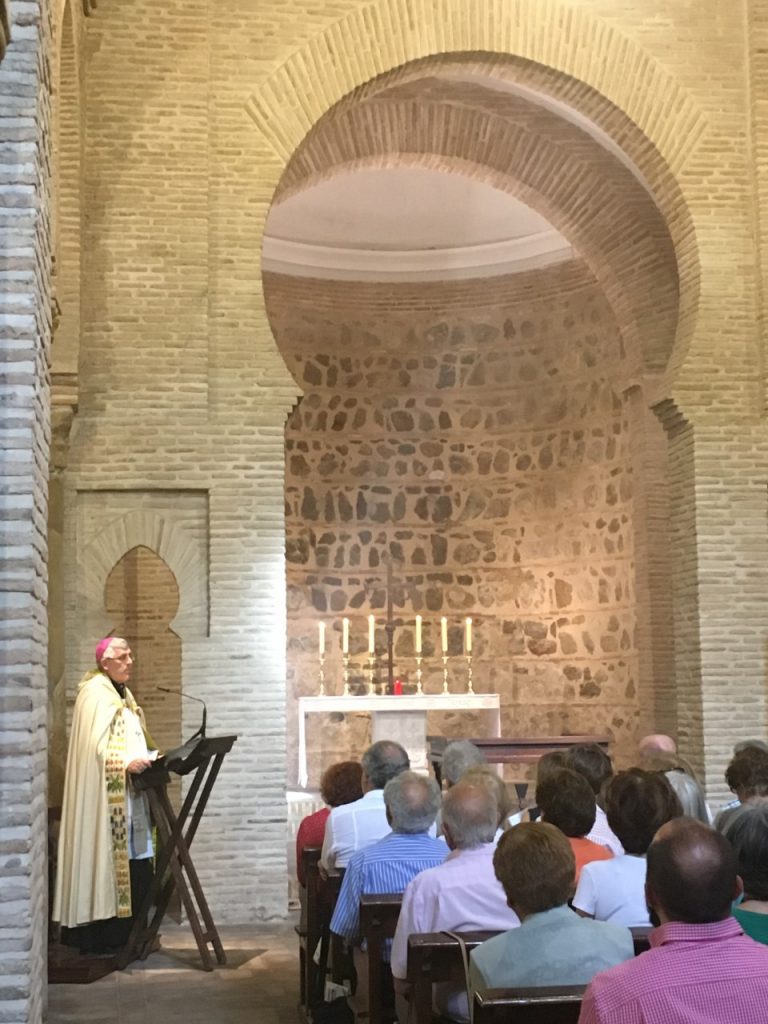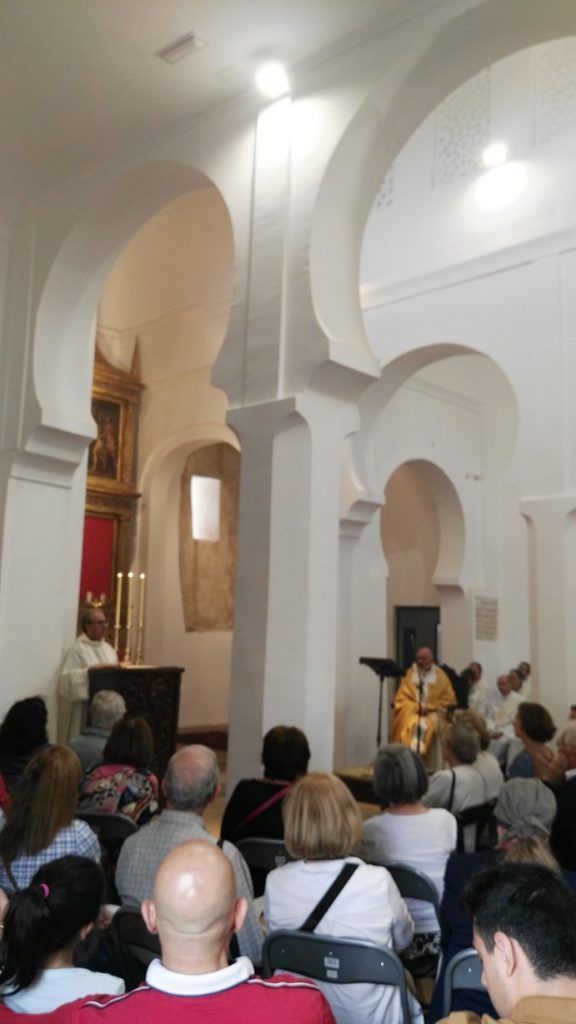
El 30 de septiembre ’17 la Asociación Hispano-mozárabe <Gothia> presidida por P Figueroa Soler realizó -como convivencia de inicio de curso- una peregrinación a Toledo. La compañía de los amigos hizo que el número de asistentes se elevara a 160 personas.
Se celebró la Misa en nuestro venerable Rito en la bella iglesia de san Lucas; presidió P Manuel y nos acogió fraternalmente el párroco, P José Antonio. Tras la comida de hermandad, en la que nos acompañó P Juan Manuel Sierra gozamos de un rato de tiempo libre y nos encaminamos con el Arzobispo Primado a la pulcra iglesia de santa Eulalia. Allí, acogidos por su párroco P Fco. Javier, tras el <Lucernarium> del diácono, la ofrenda del incienso y el Oficio de Vísperas se impusieron las cruces de <Gothia> a miembros de la Frtaernidad sacerdotal y de la Hermandad.
¡Una jornada inolvidable!




















Una experiencia muy especial que combinó espiritualidad, convivencia y formación. Muchas gracias a los organizadores!
An American Priest in Mozarabic Spain
By, Fr. David Jaspers
In 1997, as a sophomore in college, I studied abroad in Granada, Spain. I returned home having decided to be a Spanish major and having told Jesus I was open to the possibility of being a priest. It was a good year and Spain would forever be in my heart.
During my second year of seminary I discovered that among the many rites of the Catholic Church there is an ancient rite of Spain now called the Hispanic-Mozarabic Rite. I was thrilled—I already had a love for liturgy and the different rites of the Church and to discover that my beloved Spain had her own rite, I couldn’t wait to learn more!
In 2004, I found myself sitting in the pews of the Hermitage of St. Isidore the Farmer in Madrid for my first Holy Mass according to the Mozarabic rite. The priest pegged me for a seminarian and—to my joy—invited me to hold the chalice as he gave communion to the faithful saying, “May the Body of Christ be your salvation and the Blood of Christ remain with you as [your]true redemption. I left content and with photocopies of the Spanish translation of the proper prayers for the Mass of the Blessed Virgin Mary.
The priest’s name was Don Manuel Gonzalez-Corps and under his leadership the little group gathered for the weekly Mozarabic Mass in Madrid has grown. They’ve now moved to the Basilica of the Immaculate Concepcion and regularly several hundred faithful fill the pews. Don Manuel no longer has to lead the singing (and everything else for that matter), but rather a choir of devotees sings the specific hymns for the mass of the day, as well as, other songs to accompany the liturgy. On Tuesday, Sept. 26, Don Manuel was one of eight concelebrants with the Auxiliary Bishop Chow of Lima presiding at the Mass. Among the concelebrants was also a tall American priest from the Archdiocese of Portland in Oregon (That’s me!).
As usual, after Mass a core group from the Association for the Hispanic-Mozarabic Rite (Hermandad Gothia) headed to a pub for tapas. The last time I was there I was blessed to sit across from the Patriarch of Damascus and this time I was able to share stories about my time as a volunteer missionary in Peru. Five hundred years ago when the Spanish missionaries began celebrating Marriages in Peru, the rest of the New World, and the Philippines they brought with them the peculiar Mozarabic traditions of giving coins (arras) and placing the veil of the bride over the bride and groom (velo or laso). These Mozarabic traditions are now a part of the majority of weddings here in Oregon, as well.
In June, I received an email from the president of the Hermandad Gothia saying this year on September 30 there would be a pilgrimage to Toledo for the members of the mozarabic fraternity and their friends and family. I realized this pilgrimage was a beautiful step in my spiritual journey that began twenty years ago as I first stood, with tears in my eyes, in the Proto-Cathedral of Granada’s Alhambra Palace.
The pilgrimage started with three bus-loads of pilgrims driving the one hour from Madrid to Toledo. We prayed Morning Prayer from the Liturgy of the Hours and I was stunned that almost all the people pulled out their smart phones and opened the EPrex app to pray along. I was thankful to give a little fervorino about the joy of pilgrimage and being open to what the Lord had planned for us that day.
Once in Toledo, we celebrated Mass according to the Hispanic-Mozarabic Rite in the parish of San Lucas, which was founded in 641AD. Although Mass is celebrated according to the rite in various places, San Lucas is one of only two Hispanic-Mozarabic parishes in the entire world. The pastor’s heart was full of pride and joy to see the 12th century church full and to hear her white horseshoe-arched walls resounding with songs of praise.
After Mass we wound our way through the narrow medieval streets of the city stopping for a refresher and tapas. We ate lunch in the Hotel Alfonso VI—an appropriate location considering Alfonso was the king who reconquered Toledo and granted the charter that established the rights of the Mozarabic Christians who had maintained the Catholic faith during Visigothic and Islamic rule. The name Mozarab means “Mixed-arab” because in addition to Latin and their own language they spoke Arabic and wore Arabic garb typical of the time and region.
The pilgrimage ended in the other Mozarabic parish of St. Eulalia. We began with a Mozarabic candle-lighting liturgy called Lucernario. It was followed by Evening Prayer according to the Roman Rite presided over by Don Braulio, the Archbishop of Toledo. As archbishop of Toledo he is responsible for the Hispanic-Mozarabic Rite. He gave a short homily and then the members of the Hermandad Gothia were called forward to receive the fraternity medallion. As I watched Don Manuel receive his medallion from the archbishop who was his childhood pastor, seminary mentor, and is now his friend, I couldn’t help but get a little teary eyed. I look forward to the day when I receive my medallion and step more fully into the rich heritage of such a rich part of our Catholic tradition.
As we made our way back to the buses, a young woman named Matilda thanked me for being there. She said, “When foreigners are here with us, it reminds us of the universality of the Church.” Little did she realize that my presence there was a reminder to me as well of the diversity and universality of the Church.